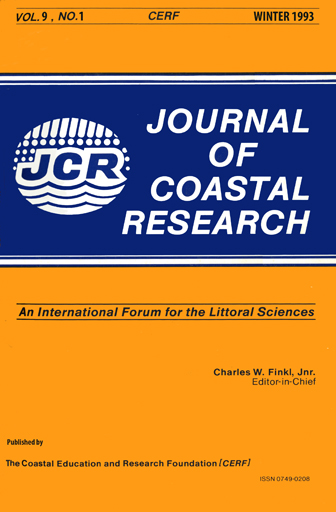Analysis of Cliff Retreat and Shoreline Erosion: Thompson Island, Massachusetts, U.S.A.
Keywords:
Boston Harbor, beach erosion, cliff erosion, cliff shear strength, grain-size compositionAbstract
Shoreline and cliff erosion rates between 1938 and 1977 were determined by photogrammetric analysis (1938, 1952, 1963, 1977 series) for Thompson Island in Boston Harbor, Massachusetts, in order to evaluate the influence of textural and shear strength properties on the erosion rates of the contiguous glacial cliffs with respect to the directions of most frequent storm approaches. Analysis of variance indicates that sediment textural characteristics and shear strengths are different by geographic exposure. A multiple regression analysis showed that percent gravel and sand: mud ratios accounted for about 70% of the variation in shear strength. The most resistant cliffs should, therefore, have the lowest average sand: mud ratios, low gravel content and high shear strengths.
The highest rates of cliff erosion were generally associated with cliffs with the highest sand: mud ratios and lowest shear strengths combined with an orientation subjected to frequent storms. The highest average rates of cliff erosion (0.4 to 0.6 m/yr) occurred in the northwest and southeast quadrants, but not in the northeast, storm-dominant quadrant. The northeast-facing cliffs have the lowest average sand: mud ratio combined with relatively high shear strengths. Average cliff erosion rates were highest for the southeast-facing cliffs where the average sand: mud ratio is high and the average shear strength measurements are the lowest.
Over this 39-year period, the mean cliff recession for the island's perimeter was about 0.3 m/yr which supplied over a quarter of a million cubic meters of sediment, while shoreline erosion was about 0.4 m/yr and supplied over 200,000 cubic meters of sediment. These sediment-budget estimates amount to nearly half a million cubic meters of materials removed from the island. They suggest that the Boston Harbor Islands can be 8 significant natural source of sediments for offshore areas.
Predictions of average cliff erosion rates may he more complex than predictions of average beach erosion rates. In addition to considering dominant storm directions, it is important to consider geotechnical properties, such as size, composition and shear strengths of cliff sediments in an attempt to predict their potential long-term erosion rates.


